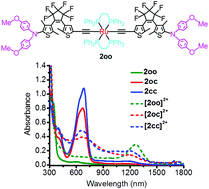Spectroscopic and electrochemical properties of ruthenium complexes with photochromic triarylamine–dithienylethene–acetylide ligands†
Abstract
A new dithienylperfluorocyclopentene–acetylide ligand (L2o) appended with a triarylamine moiety was used to synthesize two ruthenium(II) complexes with a photoswitchable electronic interaction between inorganic (Ru) and organic (triarylamine) redox centres. The reactions of cis-Ru(dppe)2Cl2 with one or two equiv. of L2o produce trans-Ru(dppe)2(L2o)Cl (1o) or trans-Ru(dppe)2(L2o)2 (2oo), respectively. As demonstrated by 1H and 31P NMR spectral studies, 2oo shows stepwise photocyclization leading first to the singly ring-closed species 2co, and then to the doubly ring-closed species 2cc upon irradiation at 312 nm. Complex 1o exhibits two separated anodic waves at 0.60 (RuII/III) and 0.86 V (N0/+) caused by inherent redox dissymmetry and electronic interaction. Upon conversion to the ring-closed species 1c, three reversible anodic waves are found at 0.28, 0.37 and 0.66 V due to the oxidation of the ring-closed DTE, triarylamine and Ru, respectively. One-electron oxidized species [1c]+ displays broad and moderately intense absorption bands in the near-infrared region induced by charge delocalization. For the oxidized species [2oo]2+/[2co]2+/[2cc]2+, charge delocalization along the molecular backbone shows a progressive increase following the stepwise photocyclization process.
Zhong-Ning Chen and Denis Jacquemin launch a collaborative research project on multi-photochromism in metal complexes encompassing several photochromic moieties. The group of Chen is devoted to the experimental synthesis and characterization of metal coordinated systems with multi-photochromic dithienylethene (DTE) moieties and the use of stepwise or selective photochromism to modulate switchable electronic communication and charge delocalization in heterometallic or inorganic–organic mixed-valence systems. Jacquemin's group focuses on theoretical investigation of the mechanism underlying the multi-photochromism through a time dependent density functional theory (TD-DFT) approach, taking into account when necessary spin–orbit couplings (SOC) so as to model potential intersystem crossings (ISC).

- This article is part of the themed collection: Sino-European Collaborators

 Please wait while we load your content...
Please wait while we load your content...